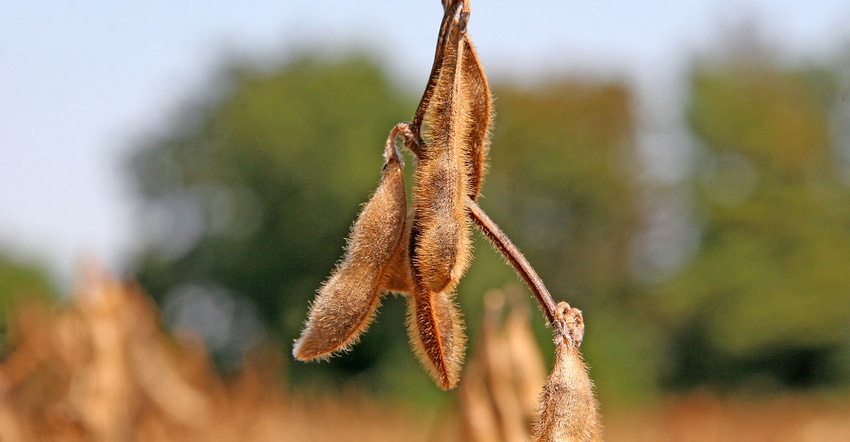
Farmers know uncertainty. It’s part of their DNA — When will it rain? How much will fertilizer go up? Will insects, weeds, disease affect yields? Which way is the market going?
That last one comes with more than the usual number of unknowns as producers near the mid-point of the 2018 growing season faced with market uncertainties exacerbated by China’s retaliatory tariffs. Soybean prices have dropped by $2 a bushel since the latest salvo in the trade war was unleashed.
“The long-term effect of the tariffs remains unknown,” says Aaron Smith, assistant professor, University of Tennessee Institute of Agriculture resource economics, in Knoxville.
Smith says the $2 loss in soybean prices comes from the tariff levy as well as prospects for a good crop. “How much of that is tariff and how much is due to the good crop prospects? I’m not sure,” Smith says. That makes up one of several unknown factors farmers face as they try to decide on marketing plans. Soybeans appear to be the most vulnerable commodity for now.
See also: How will China policy affect U.S. economic sectors?
Also uncertain, he says, is what, if anything, President Trump will do to alleviate some of the losses farmers face because of the tariffs. Trump has, on several occasions, said farmers would not bear the brunt of the back and forth with China over trade policy.
Smith says the next fam bill, currently being debated in Congress, could address the issue. Nothing would come out of that until sometime in 2019, and Smith believes a farm bill fix is doubtful.
Commodity Credit action would be more likely, he says. “But we do not see a rush to get anything done. Will we see anything in place by September? That’s not likely. I don’t anticipate anything until next year.”
Smith poses another question. “If some form of aid is approved, how will it be distributed? Will farmers be paid a flat rate per bushel or by acreage? Or will another option be available?”
He also wonders how any payment program will differentiate between farmers who priced much of their crop before the tariff and those who had none of the crop protected.
Farmers’ Options
Farmers still have market options, Smith says. “A good many Tennessee farmers priced 65 percent of the 2018 crop early. Others priced as much as 25 percent. But some have nothing priced.” Marketing options vary among those three groups. Those with a bigger percentage priced, have more options. Those at 25 percent may have fewer opportunities but at least some of their anticipated production protected. Farmers with none priced are more vulnerable to market fluctuations.
“Marketing in this climate is a tricky proposition,” Smith says. “With 50 percent or more booked, farmers can be more selective about pricing. With a good yield, they could take advantage of a market rally along the way and lock in profit.”
Producers with no contracts in place could also see opportunities to sell at profitable prices, Smith says. But they need to do some homework. “Look for opportunities. But first, you must know production costs. That’s crucial to know where to set a pricing floor. It is tough to have unpriced beans now with markets in the $8 range. Look at on-farm storage opportunity,” Smith recommends. “That’s a good tool to extend the marketing period.”
He says prices could bump up to $9 to $9.25 before harvest. “With good yields, that might offer a profit. But you must know what price is needed. I think the market will be more volatile,” he says, “but I also think we will see opportunities before September to lock in profitable prices— not as high as in the spring but better.”
Don’t Panic
“Don’t panic,” Smith says. “We’ve been in an emotional slide in soybean prices, but we have plenty of the growing season left. Look for a pricing opportunity and consider that storage option.”
He says he’s been getting calls about “unwinding a hedge. That’s also a tricky option.” He says some producers may have taken advantage of short hedges and now have some equity in the contract. “But you must know the risk.”
He says the cash market remains important. “Be aware of changes in basis. In some areas, the basis has held up.”
Smith shows some optimism. “China will need to buy U.S. soybeans at some time,” he says. “When is the million-dollar question. China has built ups stocks. They also have options in South America, and could ease import restrictions on Southeast Asia countries on a temporary basis. But they will need to come back to U.S. soybeans at some time.”
He says shenanigans are also possible. China could get U.S. soybeans through a pass-through arrangement. That happened several years ago, he says, with beef sold to Hong Kong and transshipped to China. That could happen with soybeans,” he says, “but not without political consequences.” He says U.S. trade officials will be watching big purchases from other countries.
With all the unknowns swirling around ag commodity markets this summer, especially soybeans, Smith says farmers must be watchful for opportunities to lock in a profit. And before that, they must know their costs.
“The U.S. soybean crop promises to be a good one,” he says, “but producers still should have some opportunities to sell.”
About the Author(s)
You May Also Like






